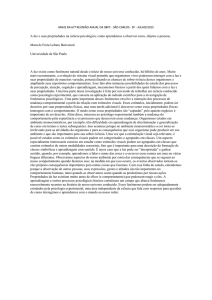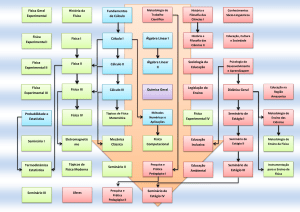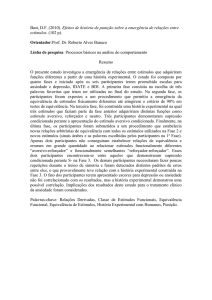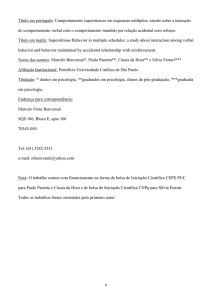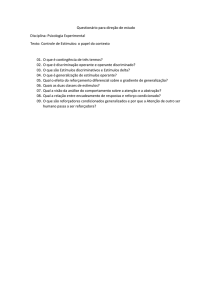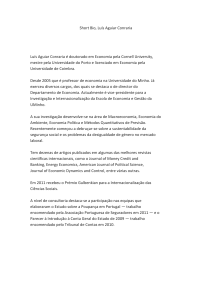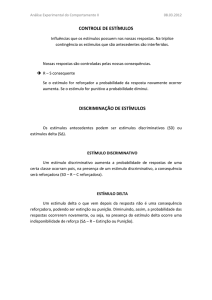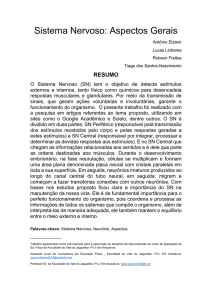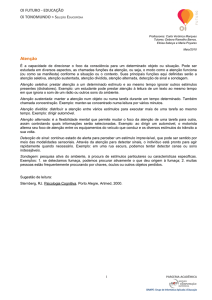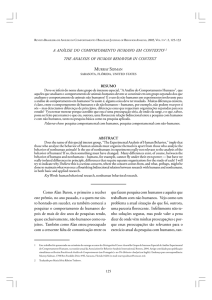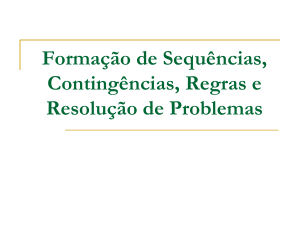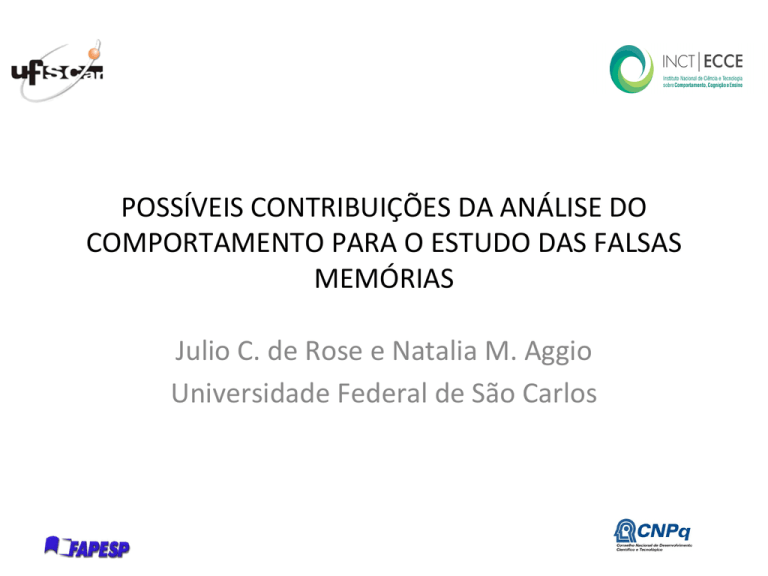
POSSÍVEIS CONTRIBUIÇÕES DA ANÁLISE DO COMPORTAMENTO PARA O ESTUDO DAS FALSAS MEMÓRIAS Julio C. de Rose e Natalia M. Aggio Universidade Federal de São Carlos As John Wixted wrote to me … “researchers have forgoQen to explain why we behave as we do. Much of what we do is a funcUon of the prior consequences of our acUons. And we learn from those consequences. CogniUve models are oWen a surrogate of that learning history (they refer to a magic computer in the head without considering what is responsible for its computaUonal abiliUes …). So, to the extent that cogniUve psychology and cogniUve neuroscience don’t care about the learning history of their subjects (and, for the most part, they don’t), behaviorism lost.” cogniUve psychologists tend to ignore learning history in their theories. If we at least begin incorporaUng learning history back into our consideraUons, then behaviorism will be making a comeback. H. Roediger (2004). What happened to behaviorism? UMA ABORDAGEM COMPORTAMENTAL DA MEMÓRIA COMPORTAMENTO DE LEMBRAR ENVOLVE MUITOS PROCESSOS COMPORTAMENTAIS PARTICULARMENTE, CONTROLE DE ESTÍMULOS (DISCRIMINAÇÃO E GENERALIZAÇÃO) Palmer (1991) Aggio et al. (2014) SINFONIA NO RÁDIO 10a SINFONIA DE SHOSTAKOVICH ELEMENTOS DE HISTÓRIA PASSADA DISCUSSÕES COM AMIGO SOBRE SHOSTAKOVICH LEITURAS SOBRE SHOSTAKOVICH (PARTICULARMENTE PERSEGUIÇÃO PELO REGIME STALINISTA) LEITURA SOBRE 10a SINFONIA: MOTIVO DSCH POR ALGUM MOTIVO, IDENTIFICAR MÚSICAS É REFORÇADOR COMPORTAMENTO COM PRÁTICA E HISTÓRIA DE REFORÇO UMA FALSA MEMÓRIA PODERIA OCORRER MESMO COM ESTE HISTÓRICO POSSIBILIDADE DE INTRUSÃO EX. SHOSTAKOVICH PROKOFIEV COMPOSITORES SOVIÉTICOS NOMES COM SOM RUSSO CONTEMPORÂNEOS PRINCIPAIS COMPOSITORES SOVIÉTICOS DA ÉPOCA STALINISTA PERSEGUIDOS PELO REGIME STALINISTA SEMELHANÇA “ADQUIRIDA” OU “MEDIADA” CATEGORIA “ARTIFICIAL” DE ESTÍMULOS 10a SINFONIA DE SHOSTAKOVICH NO RÁDIO SINFONIA DE PROKOFIEV O PARADIGMA DE EQUIVALÊNCIA DE ESTÍMULOS E A SIMILARIDADE ADQUIRIDA RELAÇÕES ENTRE ESTÍMULOS SÃO ESTABELECIDAS EXPERIMENTALMENTE EXEMPLO DE TENTATIVA DE MATCHING TO SAMPLE RELAÇÕES ESTABELECIDAS POR MATCHING TO SAMPLE ESTABELECEM UMA CLASSE DE ESTÍMULOS EQUIVALENTES: CATEGORIA ARTIFICIAL DE ESTÍMULOS OS ESTÍMULOS DA CLASSE SÃO SUBSTITUÍVEIS ENTRE SI TEM O MESMO SIGNIFICADO SÃO RELACIONADOS SEMANTICAMENTE Sidman & Tailby, 1982; Sidman, 1994 TRANSFERÊNCIA DE FUNÇÕES – “GENERALIZAÇÃO SIMBÓLICA" CHOQUE GSR (CR) GSR GSR Dougher et al. (1994, 2007) Ver também de Rose et al. (1988) Efeitos semânUcos reproduzidos com es~mulos equivalentes ERPs Barnes-­‐Holmes et al. 2005; Haimson et al., 2009; Amd et al., 2013; BortoloU et al., 2014 Priming semânUco Barnes-­‐Holmes et al. 2005; BortoloU & de Rose, 2011 Falsas memórias Guinther & Dougher, 2010, 2014; Challies et al., 2011; Aggio, 2014 Costura linha fina ponta furar injeção seringa Agulha PARADIGMA DRM GRAU DE RELACIONAMENTO SEMÂNTICO É VARIÁVEL INDEPENDENTE Deese, 1959; Roediger & McDermot, 1995 EQUIVALÊNCIA DE ESTÍMULOS GRAU DE RELACIONAMENTO SEMÂNTICO É VARIÁVEL DEPENDENTE FUNÇÃO DE PARÂMETROS DE TREINO PODE SER ESTABELECIDO ARBITRARIAMENTE, ENTRE ESTÍMULOS QUE ORIGINALMENTE NÃO TEM RELAÇÃO SEMÂNTICA GUINTHER & DOUGHER, 2010 ESTÍMULOS: PALAVRAS DA LÍNGUA INGLESA, SEM RELAÇÃO SEMÂNTICA TRÊS CLASSES DE 24 PALAVRAS CADA CLASSE EQUIVALENTE A UMA FIGURA GEOMÉTRICA RELAÇÕES SEMÂNTICAS ESTABELECIDAS ARTIFICIALMENTE ENTRE PALAVRAS SEMANTICAMENTE NÃO RELACIONADAS NA LÍNGUA ANIMAL
GARDEN BALLOON HORSE ANIMAL
GARDEN BALLOON HORSE ANIMAL-­‐BALLOON RELAÇÃO SEMÂNTICA + CO-­‐OCORRÊNCIA -­‐ ANIMAL GARDEN CARPET
JUDGE CARPET
BALLOON HORSE
JUDGE POCKET
RELAÇÃO SEMÂNTICA -­‐ CO-­‐OCORRÊNCIA + T1 (12 PALAVRAS) SEM T3 (12 PALAVRAS) T1 – LISTA DE ESTUDO ANIMAL BALLOON ARTIST BEARD AVENUE BOTTLE FREE RECALL RECOGNITION T2 (12 PALAVRAS) CO-­‐OC T4 (12 PALAVRAS) BRANCH BRICK BUBBLE CAMERA CARPET CIGAR T5 (24 PALAVRAS) 3 2 1 Passaram no teste de equivalência n = 29 0 3 Não passaram no teste de equivalência n = 13 2 1 0 T2 T3 T4 Número médio de intrusões (recall) T5 AGGIO, 2014 RELAÇÕES SEMÂNTICAS ARTIFICIAIS ENTRE PALAVRAS SEM SENTIDO CLASSES DE 11 PALAVRAS EQUIVALENTES A EXPRESSÕES FACIAIS DE EMOÇÕES JIFA LORI XEDU BEZI MOPA CAVI DUTA LAKO VORA RIBO GUVI VAPI GOCA SIMA XUVI BAPU TAJO SIJA NIDO KASU GELI MOZA RAFO SEPA TOBE ZURE FUVU KIDO FEPE PONA SUCA MEBU TIDA LISTAS PARA ESTUDO: EXCETO AS PALAVRAS EM VERMELHO Alegre"
Neutro"
100"
100"
80"
80"
60"
60"
%"
%"
40"
40"
20"
20"
0"
0"
Alvo"
Distratores"Crí5cos"
Alvos"
Distratores"não"Relacionados"
Distratores"Crí5cos"
Raivoso"
100"
80"
60"
%"
40"
20"
0"
Alvos"
Distratores""Crí5cos"
Type"of"s*muli"
Distratores"não"Relacionados"
Média"
P27"
P28"
P29"
P30"
P31"
P32"
P33"
Distratores"não"Relacionados"
1) FALSAS MEMÓRIAS COM PALAVRAS SEM SENTIDO, COM RELAÇÃO SEMÂNTICA CONSTRUÍDA ARTIFICIALMENTE POR MEIO DE EQUIVALÊNCIA DE ESTÍMULOS. 2) AS PALAVRAS SEM SENTIDO ERAM EQUIVALENTES A FACES NEUTRAS, ALEGRES OU RAIVOSAS. 3) FALSAS MEMÓRIAS FORAM AFETADAS PELO CONTEÚDO EMOCIONAL: EFEITO ROBUSTO PARA LISTA NEUTRA. A EMOCIONALIDADE DIMINUIU A OCORRÊNCIA DE FALSAS MEMÓRIAS OS ESTUDOS APRESENTADOS MOSTRAM QUE O PARADIGMA DE EQUIVALÊNCIA DE ESTÍMULOS PODE CONTRIBUIR PARA O ESTUDO DAS FALSAS MEMÓRIAS, PERMITINDO A CONSTRUÇÃO EXPERIMENTAL DE RELAÇÕES SEMÂNTICAS: O GRAU DE RELACIONAMENTO SEMÂNTICO PODE SER UMA VARIÁVEL DEPENDENTE E NÃO APENAS INDEPENDENTE. O PARADIGMA DE EQUIVALÊNCIA APONTA PARA A HISTÓRIA DE APRENDIZAGEM SUBJACENTE ÀS MEMÓRIAS, VERDADEIRAS OU FALSAS. SE COMEÇARMOS A INCORPORAR A HISTÓRIA DE APRENDIZAGEM DE NOVO EM NOSSAS CONSIDERAÇÕES, O BEHAVIORISMO ESTARÁ FAZENDO SEU RETORNO (Roediger, 2004). REFERÊNCIAS Aggio, N. M. (2014). Inves&gação sobre o estabelecimento de falsas memórias por meio do paradigma de equivalência de es;mulos. (Doctor), Universidade Federal de São Carlos, São Carlos, SP. Aggio, N. M., Varella, A. A. B., Silveira, M. V., Rico, V. V., & de Rose, J. C. (2014). Memória sob a óUca analíUco comportamental. In C. Vichi, E. M. Huziwara, H. Sadi & L. M. Postalli (Eds.), Comportamento em Foco (Vol. III, pp. 421-­‐432). São Paulo: Associação Brasileira de Psicologia e Medicina Comportamental. Amd, M., Barnes-­‐Holmes, D., & Ivanoff, J. (2013). A derived transfer of eliciUng emoUonal funcUons using differences among electroencephalograms as a dependent measure. Journal of the Experimental Analysis of Behavior, 99, 318-­‐334. Barnes-­‐Holmes, D., Staunton, C., Whelan, R., Barnes-­‐Holmes, Y., Commins, S., Walsh, D., . . . Dymond, S. (2005). Derived sUmulus relaUons, semanUc priming, and event-­‐related potenUals: tesUng a behavioral theory of semanUc networks. Journal of the Experimental Analysis of Behavior, 84, 417-­‐433. doi: 10.1901/
jeab.2005.78-­‐04 BortoloU, R., & de Rose, J. C. (2011). Avaliação do efeito de dica semânUca e da indução de significado entre es~mulos abstratos equivalentes. Psicologia: Reflexão e Crí&ca, 24(2), 381-­‐393. Challies, D. M., Hunt, M., Garry, M., & Harper, D. N. (2011). Whatever gave you that idea? False memories following equivalence training: a behavioral account of the misinformaUon effect. Journal of the Experimental Analysis of Behavior, 96, 343-­‐362. doi: 10.1901/jeab.2011.96-­‐343 Deese, J. (1959). On the predicUon of occurrence of parUcular verbal intrusions in immediate recall. Journal of Experimental Psychology, 58, 17-­‐22. de Rose, J. C., McIlvane, W. J., Dube, W. V., Galpin, V. C., & Stoddard, L. T. (1988). Emergent simple discriminaUon established by indirect relaUon to differenUal consequences. Journal of the Experimental Analysis of Behavior, 50, 1-­‐20. doi: 10.1901/jeab.1988.50-­‐1 Dougher, M. J., Augustson, E., Markham, M. R., Greenway, D. E., & Wulfert, E. (1994). The transfer of respondent eliciUng and exUncUon funcUons through sUmulus equivalence classes. Journal of the Experimental Analysis of Behavior, 62, 331-­‐351. REFERÊNCIAS (conUnuação) Dougher, M. J., Hamilton, D. A., Fink, B. C., & Harrington, J. (2007). TransformaUon of the discriminaUve and eliciUng funcUons of generalized relaUonal sUmuli. Journal of the Experimental Analysis of Behavior, 88, 179-­‐197. Dougher, M. J., Hamilton, D. A., Fink, B. C., & Harrington, J. (2007). TransformaUon of the discriminaUve and eliciUng funcUons of generalized relaUonal sUmuli. Journal of the Experimental Analysis of Behavior, 88, 179-­‐197. Guinther, P. M., & Dougher, M. J. (2010). SemanUc false memories in the form of derived relaUonal intrusions following training. Journal of the Experimental Analysis of Behavior, 93, 329-­‐347. doi: 10.1901/jeab.2010.93-­‐329 Guinther, P. M., & Dougher, M. J. (2014). ParUal contextual control of semanUc false memories in the form of derived relaUonal intrusions following training. The Psychological Record, 64, 457-­‐473. doi: 10.1007/s40732-­‐014-­‐0012-­‐4 Haimson, B., Wilkinson, K. M., Rosenquist, C., Ouimet, C., & McIlvane, W. J. (2009). Electrophysiological correlates of sUmulus equivalence processes. Journal of the Experimental Analysis of Behavior, 92(2), 245-­‐256. doi: 10.1901/jeab.2009.92-­‐245 Palmer, D. C. (1991). A behavioral interpretaUon of memory. In L. J. Hayes & P. N. Chase (Eds.), Dialogues on verbal behavior (pp. 261-­‐279). Reno, NV: Context Press. Roediger, H. L. (2004). What happened to behaviorism. American Psychological Society Observer, 17(3). Roediger, H. L., & McDermoQ, K. B. (1995). CreaUng false memories: Remembering words not presented in lists. Journal of Experimental Psychology: Learning, Memory, and Cogni&on, 21, 803-­‐814. Sidman, M. (1994). Equivalence rela&ons and behavior: A research story. Boston, MA: Authors CooperaUve. Sidman, M., & Tailby, W. (1982). CondiUonal discriminaUon vs. matching to sample: an expansion of the tesUng paradigm. Journal of the Experimental Analysis of Behavior, 37, 5-­‐22. doi: 10.1901/jeab.
1982.37-­‐5

